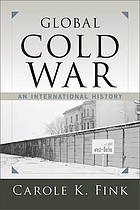
Cold War
An International History
کتاب های مرتبط
- اطلاعات
- نقد و بررسی
- دیدگاه کاربران
نقد و بررسی

October 28, 2013
The long duel between the U.S. and the Soviet Union emerges in a broad context in this insightful history of the Cold War. Fink (The Genoa Conference), professor emerita of history at the Ohio State University, grounds the book in a perspicacious review of Soviet international relations from 1917 onwards and a deft analysis of how wrangling over the fate of Germany and Eastern Europe during and after WWII laid the foundations for the coming rivalry. Her brisk narrative surveys important flashpoints of the Cold War, from the Berlin Airlift through the 1989 collapse of Soviet communism, and delineates its underlying shape as direct confrontation between Americans, Russians, and Chinese in Europe, Korea, Cuba, and Vietnam gave way to wary policies of coexistence and détente. She shows how the antagonism, while easing somewhat, also took on a life of its own as it subsumed quarrels between Arabs and Israelis, Indians and Pakistanis, or Guatemalan landlords and peasants; local conflicts the world over, she notes, entangled almost against their will two superpowers “still trapped by Cold War reflexes to seek advantage wherever possible.” Fink’s crisp, lucid prose and judicious, even-handed assessments impart a coherent arc to complex events; students especially will find this an invaluable introduction to a watershed era of modern history.

Starred review from February 1, 2014
The Cold War was a part of our lives for decades before it came to an abrupt end in 1991. It has been described and assessed in a seemingly endless array of volumes, including John Lewis Gaddis's The Cold War: A New History and editors Melvyn P. Leffler and Odd Arne Westad's three-volume The Cambridge History of the Cold War. Those readers seeking a well-written single-volume treatment now can turn to this finely wrought book. Fink (history, emerita, Ohio State Univ.; Defending the Rights of Others) turns her considerable talents to the task of producing a global history of the Cold War that extends back to 1917 when a kind of incipient cold war began between the United States and Russia during the rise of the Soviets and Lenin. Fink also covers the well-known post-World War II Cold War in Europe, but, as per her subtitle, she also explores the war's impact on the Middle East, Asia, and elsewhere. To help the novice reader, she provides a time line, a glossary, and a list of significant individuals who played key roles in the struggle. VERDICT At a reasonable price and length, and with contents that are eminently readable, Fink's history is a gem that should be in all 20th-century history collections.--Ed Goedeken, Iowa State Univ. Lib., Ames
Copyright 2014 Library Journal, LLC Used with permission.

December 15, 2013
The further we get from the withering away of the Cold War, the more likely we are to benefit from dispassionate and solid analytical accounts of the struggle. Fink, professor emeritus of history at Ohio State, has provided a compact, objective, and insightful account that illustrates how disputes over the post-WWII fate of Europe morphed into a conflict that engulfed regions across the world. For the populations in parts of Asia, Africa, and Latin America, the Cold War often became intensely hot. Fink includes the necessary historical context by examining the foreign relations of the Soviet Union after the Russian Revolution and the subsequent fear and suspicions that lay behind Soviet policy toward the West. Fink broadens her account to include China and the Chinese enigmatic relations with the supposed Soviet allies. She deftly illustrates how Third World nations became hapless pawns in the broader geopolitical struggle, and she concludes with a sharp description of the residual effects of the Cold War upon the major and minor participants. This is an ideal introductory text for college students and general readers.(Reprinted with permission of Booklist, copyright 2013, American Library Association.)

























دیدگاه کاربران